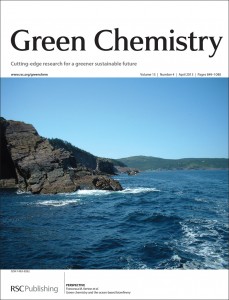Green Chemistry issue 4 is now online and you can read it here.
 The cover features work by François Jérôme and co-workers from France. Their Paper, ‘Pretreatment of microcrystalline cellulose by ultrasounds: effect of particle size in the heterogeneously-catalyzed hydrolysis of cellulose to glucose’ demonstrates that activity of a sulfonated carbon in the heterogeneously-catalyzed hydrolysis of cellulose was greatly improved by assistance of ultrasound. The paper demonstrates that the sonication method was as effective as conventional pre-treatments such as ball-milling or ionic liquids.
The cover features work by François Jérôme and co-workers from France. Their Paper, ‘Pretreatment of microcrystalline cellulose by ultrasounds: effect of particle size in the heterogeneously-catalyzed hydrolysis of cellulose to glucose’ demonstrates that activity of a sulfonated carbon in the heterogeneously-catalyzed hydrolysis of cellulose was greatly improved by assistance of ultrasound. The paper demonstrates that the sonication method was as effective as conventional pre-treatments such as ball-milling or ionic liquids.
Pretreatment of microcrystalline cellulose by ultrasounds: effect of particle size in the heterogeneously-catalyzed hydrolysis of cellulose to glucose
Qinghua Zhang, Maud Benoit, Karine De Oliveira Vigier, Joël Barrault, Gwenaëlle Jégou, Michel Philippe and François Jérôme, Green Chem., 2013, 15, 963-969
The inside front cover highlights a review article entitled ‘Green chemistry and the ocean-based biorefinery’ by Fran Kerton and co-workers at the Memorial University of Newfoundland in Canada. This review highlights that competition for land use could be minimized if marine sourced feedstocks were used for chemicals and materials production rather than crops grown on fertile land. It focuses on achievements and potential opportunities surrounding the use of algae and waste from shellfish and finfish processing.
Green chemistry and the ocean-based biorefinery
Francesca M. Kerton, Yi Liu, Khaled W. Omari and Kelly Hawboldt, Green Chem., 2013, 15, 860-871
These articles are free to access for 6 weeks!
Keep up-to-date with the latest content in Green Chemistry by registering for our free table of contents alerts.












 Work by scientists from Queen’s University Belfast on
Work by scientists from Queen’s University Belfast on